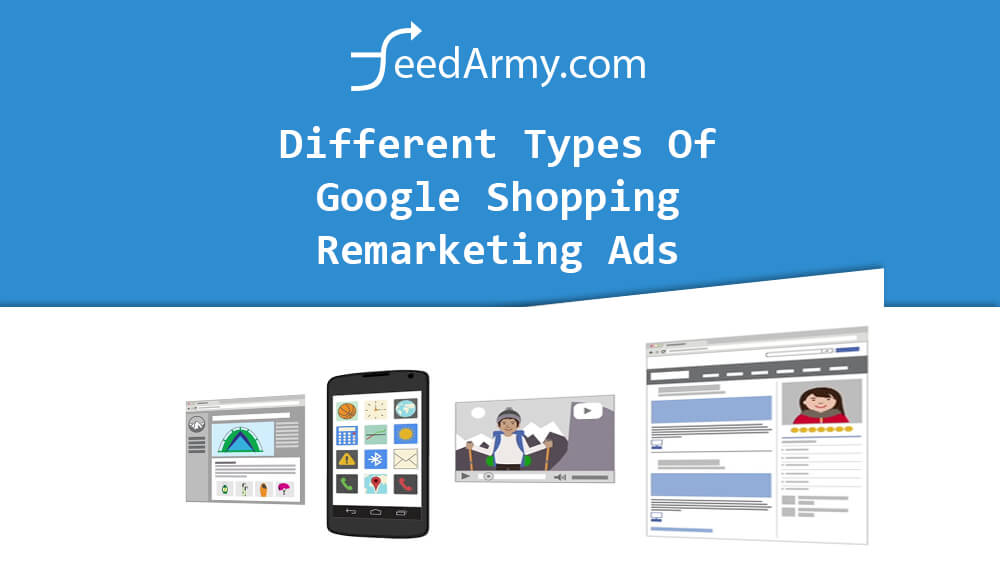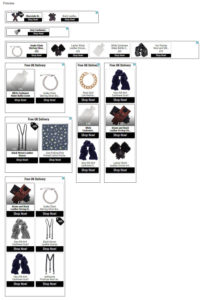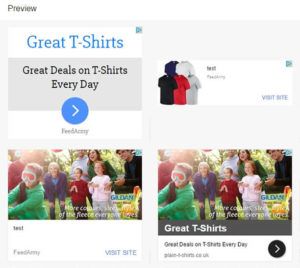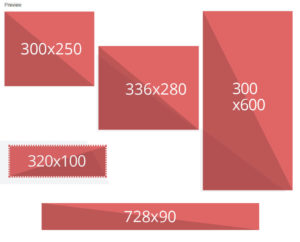When it comes to remarketing Google offers a wide range of ad formats, these are product image ads (dynamic), responsive ads or a plain static image ad. Each of these ads are different and are designed for different purposes or requirements. The best ad format to use for Google Shopping Remarketing is product image ads. Product image ads allows you to automatically show relevant products to the customer, which none of the other ad formats can do. Lets talk about each ad format and its benefits.
These ad formats are for remarketing, not normal display ads using keywords, in market or other types of targeting.
Setup requirements
To show remarketing ads, you will need to have a Adwords remarketing list, this can be generated by installing a remarketing tracking code on your website. You can also use Google Analytics, however for product image ads, you will need to use the Adwords tracking, to ensure product id’s and prices are recorded.
When are these ads shown
When a customer visits your website ether via an ad, organically (search engine or direct) or social media, they will leave a cookie on your website, this cookie will be recorded by Google Adwords. As soon as the customer leaves the site, they will be added to the remarketing list. At this point you can begin advertising on 3rd party websites.
[focus]
Tip:
When you create the remarketing list, you will need to create custom combination to ensure you exclude past buyers.
[/focus]
Find out your time lag
You can create a remarketing list with up to 540 days, however using such a large list might not be effective. You can use Google’s Attribution to find out what the time lag is. When you login to Google Adwords under Tools > Attribution, you can find out when your customers are converting. Do remember that using just Google shopping or text ads will not always accurately show the time lag, as when you are going to use remarketing the conversion lag will be longer. So do not simply cut off at 1 point and make sure to have sufficient testing.
Product Image Ads (dynamic)
There are several benefits from using product image ads :
- Use Google Merchant data feed information
- Ads are always up to date using your data feed
- Generate unique and tailored ads
- Show promotions
- Exclude products
- Automatic / Manual ad color styling
- All ad formats
- Easy setup
Utilizing the power of Google Merchant
Using product image ads, allows you to utilize the power of your Google Merchant data feed information. As shown in the image above, you can automatically show your products using the image, price and title.
Up to date
Have you changed product images, prices, titles, promotions etc…, with your data feed everything is automatically updated.
Generate tailored ads
As Google collects information about the customer, they will also know which products, price range, product category etc… they have been looking at. This allows Google to automatically generate ads based on what the customer have been looking at on your website. Each customer will than have a unique ad based on data they collect and you have in the data feed. Showing relevant ads will increase the likelihood of a returning customer.
Showing promotions
The great advantage of this ad format is the automated feature of promotions, whenever you have a discounted price or an automated promotion, Google will automatically add this to the product. As you can see in the image above, some products are shown with discounts.
Excluding products
Using your data feed, you can exclude specific products that you do not want to show, there might be a reason that you do not want to show a specific product in remarketing for business decisions.
[focus]
Tip:
You can use FeedArmy to exclude products from the remarketing list.
[/focus]
Automatic or manual ad styling
Another great advantage is the ability to let Google automatically style the ads based on your products, logo and 3rd party target website. Google will use all sources of color matching (your logo, website, image and 3rd party website) to ensure the ads are designed to attract your customer back to your website.
Ad Formats
Using product image ads will by default generate all formats. Not every 3rd party websites will want the same size. Some might want large ads, some small or even just plain text ads.
The following ad formats are automatically added :
- Text
- Native
- Image
- Text & native
- Image & native
- Native & image
Check out Google’s official documentation about ad formats.
Easy Setup
Once you have installed your remarketing code and have connected Google Merchant to Adwords, it is extremely easy to setup.
Responsive Ads
Benefits from using responsive ads :
- Control product images & styling
- Easy setup
Negatives :
- No tailored ads for individual customers
- No promotions from Google Merchant
- You can only use 2 images
Control your product images
You can setup retargeting ads by uploading your own images, the downside using this ad is that you can only upload 2 images and the ads will not be tailored on specific product matches. You can also change the color styling of the ad.
Easy setup
As with product image ads, it’s very easy to setup
Image Ads
Benefits from using image ads :
- Customize design
- Choose 18 different dimensions
Negatives :
- No tailored ads for individual customers
- No promotions from Google Merchant
- You need to design all or at least the most used ad sizes
- Allot of work to make it personalised
Custom designs
A great way to control your ads and show a specific image to your remarketing list.
With product image ads, Google automatically shows the relevant products to the customer, to replicate the same behavior you will need to create a remarketing list per category or per target group. For each list you will need to make a unique set of images. Eventually you are creating 18 images X how many categories you have. You could alternatively create 18 for all categories, but are they going to be effective?
Another issue with creating lots of different images and remarketing lists, is that you are diluting your ranking. Making the cost per clicks associated to each ad group and image higher than if you would use product image ads.
Final thoughts
From all 3 different ad formats, the product image ads will generate the most view through and click conversions as it uses dynamic information to show customers highly relevant ads. Using the other 2 formats will give you a disadvantage in not showing relevant ads, but static ads.
You can however create separate remarketing lists based on categories or pages a customer has visited, than create a specific image ad for this list. The downside is that there is allot more setup and management work required and you might reduce your ranking as you are diluting the clicks in different ad groups, while with product image ads all clicks are in 1 ad group.
You can easily test this yourself, create a campaign with all 3 ad types and simply compare the results. However I recommend product image ads.





In the new Google Ads interface, do you know if its possible to only create image versions of the dynamic product ads, and not the text, native ads?
Yes you can, simply choose display ads instead of responsive ads.